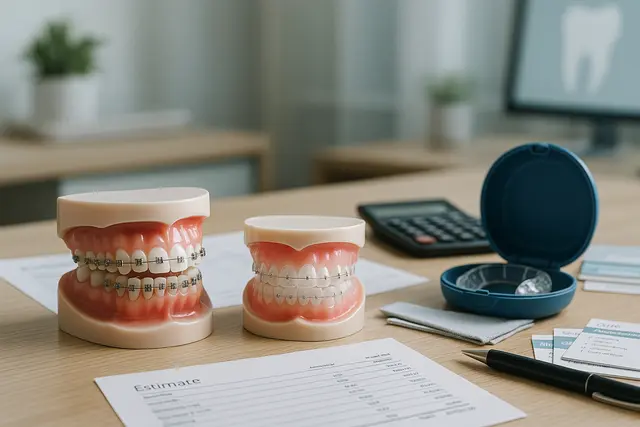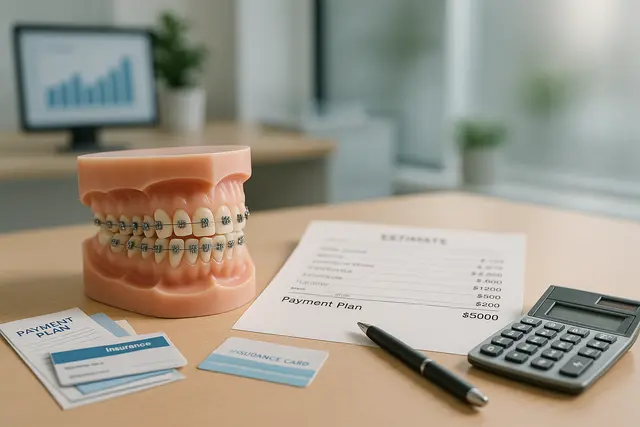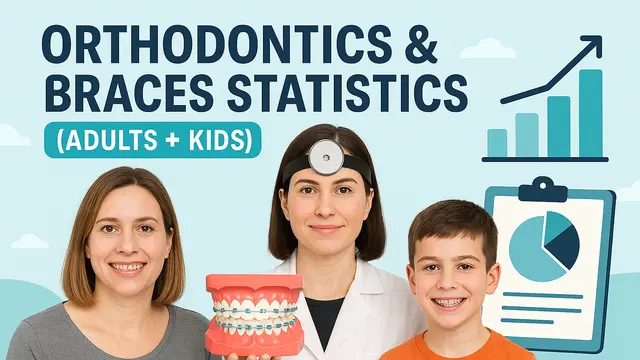Orthodontics
5 min read
Apr 03, 2025
How Long Do I Need to Wear Braces? Factors Affecting Treatment Duration
Orthodontic treatment helps straighten teeth, correct bite issues, and improve oral function. Braces are one of the most common ways to achieve these goals. But one of the first questions people ask is how long they’ll need to wear them. The answer depends on several personal and dental factors.

If you're thinking about getting braces, odds are you've already asked yourself, "How long do I need to wear braces?" It's one of the most common questions orthodontists hear, and honestly, it makes sense. No one’s thrilled about the idea of metal in their mouth longer than absolutely necessary.
The truth? There's no one-size-fits-all answer. Your treatment time could be shorter, longer, or right in the middle depending on a bunch of little factors, from the type of braces you choose to how closely you follow your orthodontist’s instructions. Let's break it down in plain, simple terms.
Treatment Time: What to Expect
The first thing to know is that the length of your treatment depends on your teeth, your jaw, and how much moving around they need. On average, most people wear braces anywhere from 18 months to about 3 years. Some lucky folks may only need a year if things go smoothly. Others may need a little more patience if their teeth are stubborn movers.
And here’s the catch nobody tells you about: if you miss appointments, forget to floss, or munch on foods that damage braces, you could be tacking extra months onto your time in braces without even realizing it.
Following your orthodontist’s game plan is your secret weapon to keeping things moving on schedule.
Orthodontic Details: It’s Not Just Straight Teeth
When people think of braces, they usually picture getting that Hollywood smile. But good orthodontic treatment isn’t just about lining teeth up like little soldiers, it’s about fixing your bite, your jaw, and your long-term health.
If you have a bad overbite, gaps, or your teeth are super crowded, that can bump up your timeline. Same goes if you need some teeth removed first to make space. Things like gum disease during treatment or bad oral hygiene habits can also throw a wrench in your progress.
Bottom line? Orthodontic care is more complex than it looks, and it's why working with a seasoned orthodontist (not just a regular dentist) matters way more than you might think.
Type of Braces: Your Choice, Your Timeline
Now for the fun part: picking the right type of braces. And yes, it makes a difference in how long you’ll need them.
Traditional metal braces are the classic option. They're strong, reliable, and usually the fastest at fixing tough cases.
Ceramic braces and clear braces blend in better with your teeth, but they can take a little longer and need more TLC since they’re easier to chip.
Self-ligating braces (the ones without the tiny rubber bands) can sometimes speed things up, depending on your case.
Thinking about going stealth? You can choose lingual braces, which hide behind your teeth. They’re awesome for invisibility but might take more time since they're trickier to adjust.
The type of braces used absolutely plays into how much time you’ll spend getting everything just right. Think of it like picking between a race car and a comfy sedan, both get you there, but the ride feels different.
Braces Treatment: A Two-Way Street
Here’s the reality no one loves hearing: your braces experience isn’t just about what your orthodontist does. It’s about what you do, every single day.
Skipping rubber bands? Not brushing carefully? Biting into hard snacks? That’s how you damage braces, and each little setback means longer in treatment.
Even things that seem harmless, like forgetting your removable braces (if you have aligners) for a day or two, can cause your teeth to move backward. That adds more months. No one wants to end up asking, "How long do you need to wear braces?" again because they had a love affair with caramel popcorn.
Stick to your orthodontist’s advice like glue, and you’ll thank yourself later when the finish line comes faster.
Aligners vs. Braces: The Real Difference
If you’re considering braces but eyeing clear aligners instead, it’s smart to know what you’re signing up for.
Clear aligners look amazing (almost invisible) and aligners are removable, which is super convenient for eating and brushing. But, and this is a big one, they only work if you wear them religiously, about 20-22 hours a day.
Take too many "breaks" and your teeth shift right back where they started, stretching your treatment time.
Aligners are great for mild to moderate issues, but if your dental issues are complicated (like a major overbite or serious crowding), traditional braces are usually the better call. Braces put more force on the teeth and can handle bigger jobs.
It’s about picking the right tool for your smile, not just the coolest-looking one.
Dentist vs. Orthodontist: Who Should You Trust?
Here’s the thing: your regular dentist is amazing for cleanings, fillings, and spotting early cavity problems. But orthodontists are the pros when it comes to straightening smiles.
They’ve gone through years of extra training just to master the art of orthodontic treatment. When you’re making a big investment in your teeth, you want someone who lives and breathes this stuff.
So if you’re wondering how long you need to wear braces and how to speed things up safely, leaning on an orthodontist’s instructions is the smartest move you can make.
Average Treatment Time: Real Talk
Let’s say it clearly: the average treatment time is about 24 months. But that number swings based on how much work your teeth need, how old you are, and how good you are about care.
Little habits like wearing your rubber bands, showing up for every appointment, and protecting your brackets from accidents can seriously keep your treatment on track.
And don’t stress if your orthodontist says you’ll be in braces for a while. Some things, like a beautiful, healthy smile, are absolutely worth the wait.
Braces Work When You Do
The magic of braces isn’t instant. It’s slow, steady pressure guiding your teeth into place, rebuilding bone around them as they move. It’s science, patience, and good habits all teaming up.
Get your braces, follow the plan, and celebrate each little milestone along the way. Whether you rock metal braces, fancy ceramic braces, or slick clear aligners, your future self, the one with the confident, gorgeous smile, is already proud of you.
How Long Do Most People Need to Wear Braces?
The average treatment time is about 18 to 24 months, but it can vary widely. Some people finish in a year, while others need up to three years depending on the complexity of their case, age, and how well they follow their orthodontist’s instructions.
What Factors Can Make Braces Take Longer?
Several things can extend treatment, like severe crowding, missed appointments, poor oral hygiene, or not wearing rubber bands as directed. Even small habits, like chewing hard foods or skipping aligners, can delay progress.
Do Different Types of Braces Affect Treatment Time?
Yes. Traditional metal braces often work the fastest, especially for complex cases. Ceramic and lingual braces may take longer due to their delicate design. Clear aligners are efficient for mild to moderate issues but only if worn consistently.
Can I Speed Up My Braces Treatment?
You can’t rush biology, but you can stay on schedule by brushing well, wearing any required elastics, avoiding bracket-breaking foods, and never missing appointments. The more consistent you are, the smoother and faster your treatment will be.
Read Next
Related Posts

Orthodontics
Retainer That Looks like Braces: Benefits for Long-Term Alignment
A retainer might not get as much attention as braces, but it plays a crucial role in maintaining your smile after orthodontic treatment. Whether you're new to retainers or curious about the type that looks like braces, understanding their purpose and benefits is key to keeping your teeth aligned for the long haul.
6 min read
Sep 15, 2025

Orthodontics
How Much Are Metal Braces? Cost Comparison With Other Options
Thinking about getting braces but overwhelmed by the cost? You’re not alone. Orthodontic treatment can be a major investment, and understanding the different price points, from metal braces to clear aligners, can help you make a smart, confident decision.
5 min read
Sep 15, 2025

Orthodontics
Orthodontics & Braces Statistics (Adults + Kids)
Orthodontics has transformed from a niche medical service for teenagers into a booming sector that spans all ages. Today, both adults and children seek orthodontic treatment to improve their smiles, fix bite issues, and boost self-confidence.
4 min read
Aug 21, 2025
Don’t have time to research every dentist around you?
See why 30k+ patients trusted us